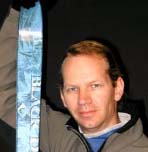
Wave Vidmar
1st American to attempt a solo unsupported
expedition to the North Pole

| |
|
Talk to Wave Live
Two lucky
classrooms will have an opportunity to talk with Wave live from
the North Pole via satellite phone!!!
Learn more |
|
 |
Purpose:
Students will gain knowledge
and skills in the understanding of arctic ecosystems,
oceanography, meteorology, communications, nutrition and cooperative
research.
Discussion
Questions:
- What is the difference
between the geographic north pole and the magnetic north pole?
- Why are there no
"markers" at the North Pole, like there are at the South Pole?
- Ordinarily a compass
would be the primary instrument for navigation and orientation
over land. But because of the difference in location of the
geographic north pole and the magnetic north pole, a compass
is not entirely accurate or effective. What do you think Wave
will use for navigation?
- What type of vegetation
and animals live at the North Pole?
- What are the
environmental conditions at the North Pole?
- Average temperatures
at the pole are -30°F, and can go as low as -74°F, with
wind-chill can go as low as -150°F. How do you think Wave will
keep warm?
- How many calories will
Wave have the consume to have the energy to travel 660 miles
in 60 days? What kind of foods do you think he will eat?
- What items (i.e.
shelter, food, cooking utensils, clothing) do you think Wave
will need to survive for 60 days at the North Pole?
- If you found yourself
lost in the wilderness, what things would you do or not do to
survive?
Suggested
Activities:
- Have the students make
a
chart
or graph of the high and low
temperatures in their city for 30
days. Compare the temperatures of their city with other
classrooms in different parts of the world.
- Research the type of
wildlife that can be found at the North Pole. What do these
animals eat? Who are their predators?
- Have students make a
chart
or graph of their own nutrition habits, by listing everything
they eat and the time it is eaten. Look up the
caloric
value of each food. How many calories are they eating each
day?
- Have students research how many
calories they burn during various activities.
- Take the
interactive Arctic quiz to learn about the factors that
affect the annual mean temperature cycle in polar regions.
- Gakkel Ridge is
one of the least explored places on our world. View the
video and the accompanying virtual slide show of this
historic mission.
Science
Resource Links
|